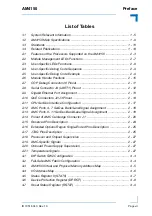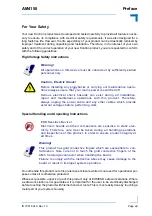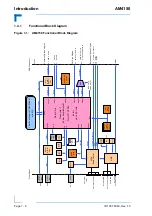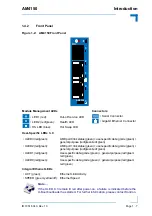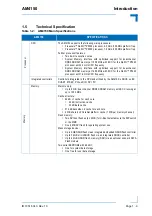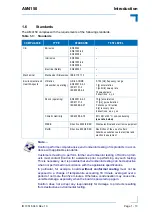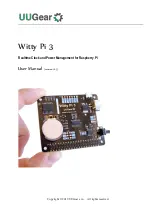
AM4150
Introduction
ID 1051-5040, Rev. 1.0
Page 1 - 3
P R E L I M I N A R Y
1.
Introduction
1.1
Board Overview
The AM4150 is a highly integrated CPU board implemented as a Single, Mid-size Advanced
Mezzanine Card (AMC) module. The design is based on the Freescale™ QorIQ™ P5020 dual-
core Power Architecture® processor with integrated high-speed interconnect technology to
balance processor performance with I/O system throughput for networking, storage, wireless
infrastructure and general-purpose embedded applications.
The QorIQ™ P5020 processor is a highly integrated 64-bit system-on-chip (SOC) platform with
up to
2.0 GHz core clock speed consisting of two e5500 cores, each with 32 kB L1 instruction
cache, 32 kB L1 data cache and 512 kB backside L2 cache. Further processor features include
a dual DDR3 memory interface, 2 MB shared L3 CoreNet platform cache (1 MB per memory
channel), five Datapath Triple-Speed Ethernet Controllers (dTSECs), and either two x4 Serial
RapidIO™ fabric interfaces or two x4 PCI Express I/O interfaces. Furthermore, one NAND flash
memory (SSD) with up to 64 GB can be integrated into the AM4150 via a SATA Flash module.
The processor and the memory are soldered on the AM4150 which results in a robust design,
higher Mean Time Between Failures (MTBF) and a significant improvement in cooling.
The AM4150 includes up to 8 GB unbuffered, dual-channel Double Data Rate (DDR3) memory
with Error Checking and Correction (ECC) running at up to 1300 MHz. The board further provides
up to 2 GB NAND flash memory via a NAND flash controller integrated in the processor.
As a “headless” AMC design (no onboard graphics controller), the AM4150 supports one stan-
dard RS-232 serial port (UART1) and up to two Gigabit Ethernet ports on the front panel as well
as a variety of high-speed interconnect topologies to the system. In the Common Options Re-
gion up to two Gigabit Ethernet SerDes and up to two SATA interfaces are supported. In the
Fat Pipes Region PCI Express, Serial RapidIO, and Gigabit Ethernet SerDes interfaces can be
selected. In the Extended Options Region a debug port and a serial port are provided.
The AM4150 has full hot swap capability, which enables the board to be replaced, monitored
and controlled without having to shut down the ATCA carrier board or the MicroTCA system. A
dedicated Module Management Controller (MMC) is used to manage the board and support a
defined subset of Intelligent Platform Management Interface (IPMI) commands and PICMG
(ATCA/AMC) command extensions, which enables operators to detect and eliminate faults
faster at module level. This includes monitoring several onboard temperature conditions, board
voltages and the power supply status, managing hot swap operations, rebooting the board, etc.
All in all, IPMI enhances the board’s availability and reliability while reducing the operating
costs and the mean-time-to-repair.
Optimized for high-performance, packet-based telecom systems, the AM4150 is targeted to-
wards, but not limited to the telecom market application such as radio network controllers, me-
dia streaming, traffic processing, database management and routing. The AM4150 also fits into
all applications situated in industrial environments, including I/O intensive applications. The
careful design and the selection of high temperature resistant components ensure a high prod-
uct availability. This, together with a high level of scalability, reliability, and stability, make this
state-of-the-art product a perfect core technology for long-life embedded applications.
The AM4150 is offered with various Board Support Packages such as VxWorks and Linux.
Please contact Kontron for further information concerning the operation of the AM4150 with
other operating systems.
Содержание AM4150
Страница 10: ...Preface AM4150 This page has been intentionally left blank Page x ID 1051 5040 Rev 1 0 P R E L I M I N A R Y...
Страница 16: ...Preface AM4150 This page has been intentionally left blank Page xvi ID 1051 5040 Rev 1 0 P R E L I M I N A R Y...
Страница 17: ...AM4150 Introduction ID 1051 5040 Rev 1 0 Page 1 1 Introduction Chapter 1 1 P R E L I M I N A R Y...



